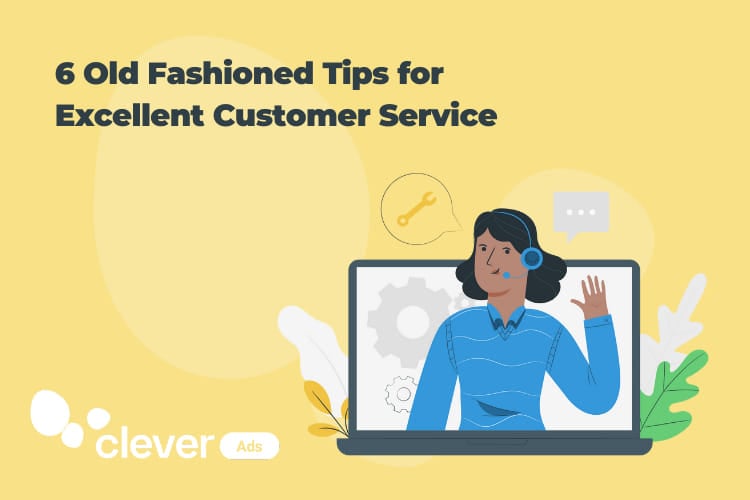Customer service tips that never get old
Remember when grandpa used to say:
“When I was your age, I had to walk six miles, barefoot, through a blizzard to get to school.”
While the daily commute was a bit more complicated back then, customer service methods couldn’t have been simpler. Good old fashioned kindness and respect was the key to a customer’s heart—and decades later the classic methods still apply! Clever uses modern methods and approach Internet to the customers.
1. Send a thank you note
It’s easy to think that customers leave for competitors because of better prices or offerings, but most of your customers are leaving because they don’t feel valued. Approximately 68% of businesses lose customers because they think that the brand is indifferent to their loyalty. If you want to make your customers feel valued, show some appreciation the old-fashioned way with a handwritten thank-you note.
These days we’re overwhelmed by persistent notifications, so much so that it’s easy to filter these messages out. In order to break through the noise and stand out from the crowd, a handwritten note will deliver a personalized and special touch to your customer service.
I remember being ecstatic and touched by the thank-you note that came with my L.L. Bean boots. It wasn’t complicated either, just a simple thank you from both the company and the employee who sewed my boots. The letter humanized the company and showed me that they cared about my commitment to the brand. That letter alone encouraged me to become a brand advocate and recommend the brand to my friends and family.
2. Be confident
“I don’t know.”
It’s the last thing a customer wants to hear, but sometimes we can’t help it. Confidence is one of the hardest things to overcome in a customer service role, especially newcomers. The reality is customers expect you to know your stuff.
You can build up confidence by shadowing more seasoned employees, researching your product, and asking a lot of questions. It takes time, but it will pay off in the long-run with happy and satisfied customers.
Additionally, it’s important for management to empower their employees by giving them increased autonomy over their role. The front line team deserves to have control over their roles, so allow them to make their own decisions within reason. By implementing user lifecycle management tools and providing employees with the resources they need to succeed, businesses can foster a culture of ownership and accountability that ultimately benefits both the team and the customer.
Disney has confidence-building mechanisms baked right into their customer service training and culture. Employees are empowered to never say “no” or “I don’t know” by collectively brainstorming alternative responses. Additionally, employees go through intensive experiential training to brush up their skills and deliver an out-of-this-world customer experience.
3. Build relationships
In an age of rapid technological innovation and a hard-line focus on efficiency, we sometimes forget about the importance of building meaningful relationships with our customers. Customers aren’t just a number—they’re human, just like you.
One of the biggest challenges of eCommerce is building relationships and trust with customers. A customer can walk into a local shop and get to know the owner, the same can’t be said for eCommerce .
That’s why you need to humanize your website and create convenient communication channels—make your store feel like the local shop down the street. In a modern twist on old-fashioned methods, consider tools like live chat, email marketing, and a CRM to maintain strong relationships and communication. Using a shared inbox is another effective way to streamline communication and ensure that all customers receive a timely and personalized response to their inquiries
Whether you have a customer base of 100 or 1 million, make sure every customer feels respected and valued in every interaction.
- Try to boost your eCommerce ads with our integration!
4. Deliver active support
The gold standard of customer service. Don’t let your customers stew in their frustration—be there the moment a problem arises in order to maintain a positive customer experience. If you can reach your customers before their frustrations begin, you will surely earn their respect and loyalty, and it will encourage them to recommend your brand to others.
Delivering proactive support is a matter of finding the moments in the customer journey that are likely to present issues. Back in the day it meant being patient and observing patterns in customer interactions in order to mitigate any issues. These days it can be achieved by using web analytics and customer feedback to identify pain points in the buying journey.
For example, if a customer inputs the wrong order credentials after checking out, implement a live chat at checkout in order to deal with the issue right away. This way your customer gets what they want, and you’ve earned a loyal customer.
5. Keep calm with unhappy customers
Remember: you’re a professional. When faced with an unhappy customer, it’s easy to become overwhelmed and flustered by the situation. Keep in mind no matter how rude, wrong, or loud your customer is being, never engage with the same level of agitation.
It is your job to keep the situation under control, and you can do this by maintaining a level-head and leading the conflict to a solution. If you’re having trouble developing a structured approach, consider Disney’s HEARD method for de-escalating service failures.
HEARD stands for: Hear, Empathize, Apologize, Resolve, Diagnose.
This approach is so effective because it empowers you to be compassionate, transparent, and diligent in solving the service issue. Disney doesn’t see service failures as mistakes, but rather as opportunities to build greater customer loyalty.
6. Set the right expectations
The last thing you want to do is overpromise and underdeliver.
Along with being confident and authentic in your customer interactions, it’s important to maintain a transparent and honest exchange when dealing with an issue. Before diving into the details, be sure to establish the right expectations in order to avoid further conflict with the customer. Additionally, inflating customer expectations makes it more difficult to build customer loyalty.
Being transparent from the get-go will help frame a customer’s expectations for the exchange and avoid any confusion as the interaction progresses. You don’t want a customer going in with certain expectations, only to realize they’ve wasted their time seeking an impossible solution.
The Ritz Carlton Leadership Center emphasizes the importance of setting customer expectations in their leadership training program. Their methodology ensures that no stone is left unturned during customer interactions. Any possible assumption by a customer is to be established and clarified in order to create a positive service experience.
Old fashioned customer service… Is back in style!
After reading this list, I encourage you to self-audit your customer service practices. Focus on the customer, put yourself their shoes, and observe the feelings and emotions that arise from a customer service interaction. Does it feel cold and methodical? Are you walking away indifferent to the brand? If yes, consider the above tips to reinvigorate your strategy with classic methods. By combining the old with the new, you’ll create an unforgettable customer experience.
About the author:
Zach is a loyalty marketing expert at Smile.io.





I think confidence is the best thing that matters in an e-commerce site